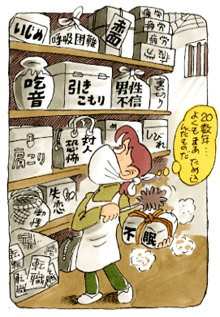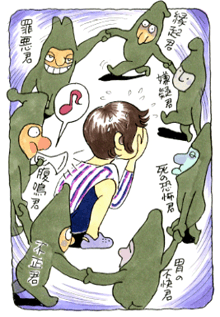Neurosis takes various forms. This section summarizes some representative neurotic disorders.
Phobic anxiety disorders

Phobic anxiety disorder is the broad classification under which conditions commonly known as phobias fall.
Phobias are characterized by extreme anxiety or irrational fear about objects or situations that would not typically be considered dangerous. Phobic anxiety disorders can be roughly classified into three distinct types: agoraphobia, social phobias and specific phobias.
Agoraphobia
Once known as fear of open spaces, agoraphobia is an intense anxiety or terror associated with places or situations from which escape may be difficult, or in which help may not be readily available.
People with agoraphobia may, for example, experience extreme fear of entering crowded or enclosed places, including stations, department stores and movie theaters. They may dread using trains, buses or other forms of public transportation. Agoraphobia is often characterized by attempts to avoid the places and situations that cue the fear. It is strongly associated with panic disorder, often developing amid recurrent panic attacks.
Social phobias
Neurotic disorders classified as social phobias are sometimes referred to as fear of interpersonal relations, or social anxiety. Whereas anyone might be nervous about speaking before large groups or meeting others for the first time, or may feel some embarrassment in the course of everyday interactions, for a person with social phobia these circumstances can trigger severe anxiety and nervous distress. Consequently, the condition may interfere with their ability to speak in social situations or participate in daily conversation, and the individual may try to avoid these situations. Ultimately, interference with social functioning may make it impossible to go to school or work, or otherwise participate in society.
Social anxiety is characterized by fear of being an embarrassment in social interaction (taijin kyofusho), fear of blushing, and/or fear of going out from home, among many others. Often, the anxiety, nervous distress and physical symptoms that manifest in people with this condition can cause them to try and avoid personal and social interaction altogether.
Central to the form known as taijin kyofusho, or fear of interpersonal relations, is dread for the potential embarrassment of drawing the attention – and perhaps the criticism – of other people. This may manifest as extreme stage fright when an individual with the phobia attempts to speak in front of others, for example, or as a quivering hand when the person has to write something with others watching.
Symptoms seem to vary by circumstance. They include fear of blushing, fear that one’s facial expression might cause offense or embarrassment, and fear of making (or making excessive or insufficient) eye contact.
Specific (isolated) phobias
A specific phobia is an extreme fear or aversion to some particular object or situation. Examples include fears related to: animals (such as insects and spiders); natural phenomena (like earthquakes, thunder and darkness); specific situations (including being in small, enclosed places); and blood, injury, or witnessing injury.
Other anxiety disorders
Anxiety disorders which fall under this classification are characterized by anxiety that is not limited to specific triggering objects or events. In other words, “other” anxiety disorders are the non-phobic variety. The major anxiety disorders of this type are generalized anxiety disorder and panic disorder.
Panic disorder
Panic disorder is a condition characterized by recurrent panic attacks. Sometimes referred to as anxiety attacks, these sudden episodes of intense fear and anxiety have psychological symptoms, such as fear of imminent death, or passing out. At the same time, a person suffering a panic attack will also experience a variety of autonomic nervous symptoms, including palpitations, tachycardia (abnormally rapid heartbeat), chest pain, nausea, sweating, dizziness, and difficulty breathing. Panic attacks are characterized by their sudden onset and relatively short duration: an episode may peak in a few minutes or last an hour or so.
Patients are often rushed to the hospital, but in most cases, the symptoms dissipate on their own by the time the person arrives.
Generalized anxiety disorder
In contrast to the abrupt surge of anxiety seen in panic disorder, the major marker for generalized anxiety disorder is chronic and persistent worry, with anxiety variously directed toward a wide range of objects and situations in everyday life.
For example, people with panic disorder may focus on the possibility that they are going to meet with a traffic accident, or that some problem with their family’s well-being may be developing. This serial worrying brings on a continuous state of nervous tension.
Mixed anxiety depressive disorder
This disorder occurs in individuals who suffer from depression and anxiety symptoms at the same time, but in whom neither predominates. Thus, symptoms are not severe enough for a diagnosis of anxiety disorder, panic disorder, or generalized anxiety disorder on the one hand, or of depression on the other.
While the symptoms of anxiety and of depression may be relatively mild, the two in combination – mixed anxiety depressive disorder – can persist for prolonged periods.
Obsessive-compulsive disorder

Obsessive-compulsive disorder is an example of a classic neurotic condition that has been known from ancient times. The main symptoms are repetitive behaviors or mental acts that a person feels driven to perform, in response to an obsession.
Obsessions are intrusive, recurrent thoughts or images that are experienced as distressing or fearful. Typically, the individual recognizes that these thoughts are senseless or excessive, but feels compelled to continue engaging in them, and powerless to stop. Typical obsessions include the fear of making a dreadful mistake and being responsible for something horrible; the fear of harming one’s self or others; or the fear of dirty or contaminated items.
Compulsions are ritual actions that the person feels a need to perform in order to rid themselves of the anxiety the obsession provokes. Although the individual may realize that the rituals are absurd, they nevertheless feel compelled to repeat them. Among the most common compulsive behaviors are excessive or ritualized hand-washing or bathing, and repeatedly checking things (such as someone making sure that their keys are still in their possession), among other confirmation rituals. The individual engages in these behaviors in an attempt to lessen the likelihood of some fearful outcome, such as overlooking something, or encountering danger or bad luck.
Somatoform disorders
Somatoform disorder is a relatively recent term for a group of psychological conditions in which a person experiences and presents with physical symptoms that cannot be explained by any underlying medical condition. In this type of disorder, even when a patient is assured by the physician that there is no medical problem, the individual may repeatedly and persistently seek further medical attention and/or information in a quest to discover a medical cause for the symptoms.
Somatization disorder
This disorder, more prevalent in women than in men, characteristically causes physical symptoms which manifest as varying medical complaints over time, involving different areas of the body. The most common symptoms include abnormal skin sensations and gastrointestinal distress, including nausea and pain in the upper or lower stomach. Somatization disorder is similar to hysteria, the classification under which its symptoms were once identified.
Hypochondriacal disorder
Hypochondriacal disorder involves the persistent feeling or belief that one has a serious illness, such as cancer – a preoccupation which may lead the individual to relentlessly pursue medical treatment or testing. The obsessive and unrealistic belief that one’s face or body appearance is particularly ugly, unattractive or deformed is also classified as a type of hypochondriacal disorder.
Somatoform autonomic dysfunction
Symptoms of this disorder are psychogenic, but present as if they were due to a physical disorder of a system or organ under autonomic control – known as autonomic dysfunction. These symptoms may include cardiac neurosis, gastric neurosis, irritable bowel syndrome, psychogenic cough, and increased frequency of daytime urination.
Persistent somatoform pain disorder
Persistent somatoform pain disorder is characterized by persistent pain which, although it is not caused by an organic or physical disorder, is nevertheless experienced as continuous, severe and distressing.
